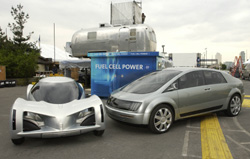GM expects that fuel-cell cars will carry hydrogen gas, which will be reformed from gasoline or natural gas at the filling-station level. The company is also working on solar and wind-generated hydrogen, though it admits that's further in the future.
 |
| The Fuel Cell Future |
The problem is that skeptics like Joe Romm (author of The Hype About Hydrogen) don't expect fuel-cell cars to arrive until 2030, if they ever arrive. But Burns, whose company has been taking out giant, two-page newspaper spreads touting the new energy, says "We've been saying and still strongly believe that will happen by 2010."
If GM can field a fuel-cell car by 2010, it would certainly silence the critics.Burns is fond of saying, "Anywhere there is natural gas, electricity or water, there is hydrogen." It is indeed the most abundant element in the universe, but the problem (as Romm's book makes abundantly clear) is separating the hydrogen from its host. The processes are energy-intensive and, unless renewable power is involved, polluting. There are serious obstacles there. Still, the alternatives are pretty horrific--notice all the new books with titles like "The End of Oil?"--and you have to be hopeful once in a while.
GM is also finally delivering its first hybrid vehicles, following Ford's splash with the hybrid Escape in New York last month. The company delivered the first V-8-powered hybrid Silverado pickup to Dade County, Florida May 3. Though the fuel-economy improvement is minor--only 10 to 12 percent--it would add up if it were applied to the hundreds of thousands of pickups GM sells annually. Unfortunately, Dade County's fleet only includes 50 trucks, and GM isn't planning to sell more than a few thousand in 2005.
According to John Gaydash, a GM fleet spokesperson, the hybrid technology will add $2,500 to the price of the truck. It might take quite a while with that limited fuel improvement to recoup the investment. Of perhaps larger fuel savings is the new displacement-on-demand (DOD) technology, which shuts down banks of cylinders in Chevy Vortec V-8 engines (for an eight percent improvement) when the extra power isn't needed. GM plans to make that technology standard in such vehicles as the Trailblazer EXT, Envoy XL and XUV in 2005. Since every buyer will get DOD, it should have a real-world effect.